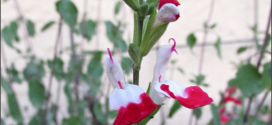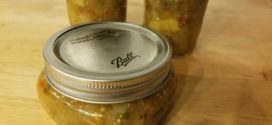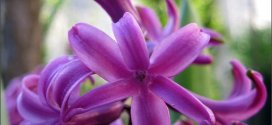Autumn Sage, Salvia x jamensis ‘Hot Lips’ Family: Lamiaceae (lay-mee-AY-see-ee) (Info) Genus: Salvia (SAL-vee-uh) (Info) Species: x jamensis Cultivar: Hot Lips Synonym:Salvia microphylla Category: Tropicals and Tender Perennials Height: 36-48 in. (90-120 cm) 4-6 ft. (1.2-1.8 m) Spacing: 18-24 in. (45-60 cm) Hardiness: USDA Zone 8a: to -12.2 °C (10 °F) USDA Zone 8b: …
Read More »admin
Cherry – Bing
Bing is a cultivar of the wild or sweet cherry (Prunus avium) that originated in the Pacific Northwest, in Milwaukie, Oregon, United States. The Bing remains a major cultivar in Oregon, Washington, California, Wisconsin and British Columbia. It is the most produced variety of sweet cherry in the United States. The Bing cherry is not self-fertile (you need another cherry …
Read More »Strawberry
Strawberry
Read More »Amaryllis – Christmas
Amaryllis, Christmas, Hippeastrum x ? Family: Amaryllidaceae (am-uh-ril-id-AY-see-ee) (Info) Genus: Hippeastrum (hip-ee-ASS-trum) (Info) Species: x ? Category: Bulbs Height: 18-24 in. (45-60 cm) Spacing: 6-9 in. (15-22 cm) Hardiness: USDA Zone 6a: to -23.3 °C (-10 °F) USDA Zone 6b: to -20.5 °C (-5 °F) USDA Zone 7a: to -17.7 °C (0 °F) USDA Zone …
Read More »Lobelia
Blue Lobelia, Lobelia siphilitica Family: Campanulaceae (kam-pan-yew-LAY-see-ee) (Info) Genus: Lobelia (low-BEE-lee-a) (Info) Species: siphilitica (sigh-fy-LY-tih-kuh) (Info) Category: Perennials Height: 24-36 in. (60-90 cm) Spacing: 18-24 in. (45-60 cm) Hardiness: USDA Zone 4a: to -34.4 °C (-30 °F) USDA Zone 4b: to -31.6 °C (-25 °F) USDA Zone 5a: to -28.8 °C (-20 °F) USDA …
Read More »Harvest Relish
It is almost Halloween in our Sunnyvale garden. The tomato, pepper and cucumber plants are just going through the motions: The tomato plant has a few flowers but there are no pollinators. The green fruit is still green. The peppers are ever so slowly turning red. The night-time lows are more often below 50 degrees than above. And it rained …
Read More »Schwarzkopf
Aeonium arboreum “Schwarzkopf Black Rose” Succulent is a Latin word meaning juicy, and is descriptive of many plants and plant families that store water in their leaves, stems and roots. Succulents can survive long periods of drought, even to a year, with this storage capacity. Aeoniums have handsome rosettes of fleshy leaves, one of which bears a spectacular terminal holding …
Read More »Fig – Black Mission
Common Fig, Edible Fig, Higo, Mission Fig, Ficus carica Family: Moraceae (mor-AY-see-ee) (Info) Genus: Ficus (FY-kus) (Info) Species: carica (KAIR-ih-kuh) (Info) Category: Trees Height: 6-8 ft. (1.8-2.4 m) Spacing: Unknown – Tell us Hardiness: USDA Zone 7a: to -17.7 °C (0 °F) USDA Zone 7b: to -14.9 °C (5 °F) USDA Zone 8a: to -12.2 …
Read More »Hyacinth
Dutch Hyacinth, Hyacinthus orientalis. Attractive to bees, butterflies and/or birds. Flowers are fragrant. This plant is suitable for growing indoors. Average Water Needs; Water regularly; do not overwater. Flowers are good for cutting Severe poisoning from hyacinth or tulip poisoning is often seen when dogs dig up freshly planted bulbs or having access to a large bag of them. When …
Read More »Narcissus – Paper White
Narcissus papyraceus (from papyrus and aceus; meaning paper-like), one of a few species known as “Paperwhite,” is a perennial bulbous plant native to the western Mediterranean region, from Greece to Portugal plus Morocco and Algeria. The species is considered naturalized in the Azores, Corsica, Texas, California and Louisiana. The white flowers are borne in bunches and are strongly fragrant. It …
Read More »








